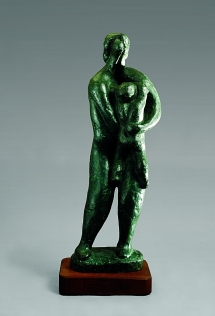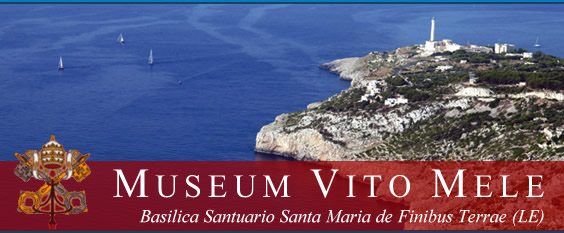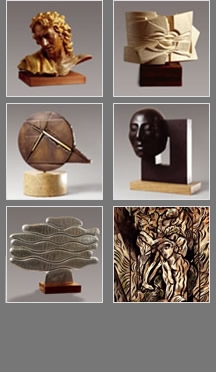|
Nasce nel 1915 a Galatina, dove frequenta il
Liceo classico. Nel 1940 si laurea in Scienze
Naturali presso l’Università di Napoli.
Dopo la guerra - alla quale partecipa - insegna
per diversi anni nei Licei classici, terminando
la sua carriera come Preside di Scuola
Media inferiore. Parallelamente all’attività
di docente, coltiva la passione per l’arte.
Nel 1947, infatti, comincia a interessarsi all’arte
ceramica, producendo numerose opere di piccolo
formato ma anche di grande, come i tre monumentali
pannelli (circa dieci metri quadrati) collocati
sulla facciata dell’edificio della Scuola
Media di Alezio. Nel 1957 fonda, a Parabita, una
piccola Scuola d’Arte, aperta ai giovani
e, soprattutto, gratuita: l’odierno Istituto
d’Arte. Partecipa a numerose mostre e rassegne
artistiche di carattere nazionale, come la VII
Quadriennale di Roma. “Piscopo - scrive Giancarlo
Vallone nel 1991 - non è uno scultore istintivo.
Egli conosce bene il messaggio essenziale della
scultura
moderna, che annunzia la forza formale ed evocativa
della materia e, ecletticamente, i referenti variano
da Moore a Marini e Manzù.
(…) Un’origine salentina di Piscopo
- continua Vallone - può aver giocato in
questo ritorno più per le convinzioni tematiche
che per l’uso (…) dei materiali: la
sua pietra è di tufo, olivo e fico i legni
(…)”. Vive e lavora a Parabita.
|

MATERNITÀ,
1995
bronzo, h. cm. 57
|
|
|
|
|
Giuseppe Piscopo was born in Galatina in
1915 and attended the Liceo before going on to
graduate in Natural Sciences at Naples University.
After the war, in which he took part, he taught
for several years and became director of a middle
school. In parallel with teaching, he cultivated
his passion for art. His interest in ceramics
dates back to 1947 and he has produced numerous
works which include three monumental panels (approximately
ten square metres in size) for the facade of the
middle school at Alezio. In 1957 he founded a
small art school at Parabita which was
open to the young and was entirely free. He exhibited
his work at the 7th Rome Quadriennale and in many
other exhibitions. It is Giancarlo Vallone’s
view that Piscopo is not an instinctive sculptor.
He knows the essential message of modern sculpture,
which speaks of the formal and evocative power
of the material, as variously seen in the works
of Moore, Marini and Manzù but his Salentine
origins may well have played a part in his return
to the pursuit of thematic conviction rather than
the exploitation of the material. His stone is
tufo, and his wood is olive and fig.
Piscopo lives and works in Parabita.
.
|





